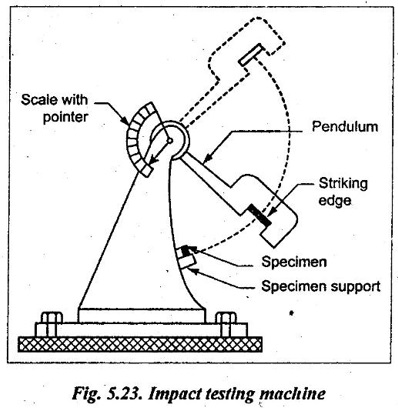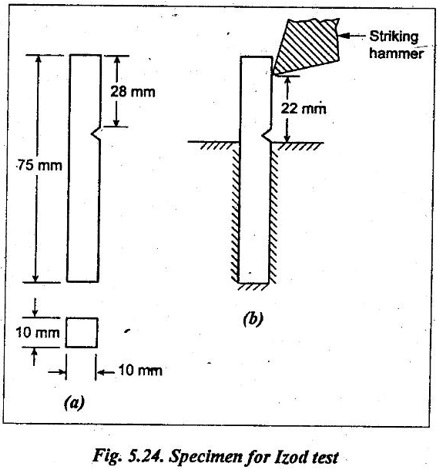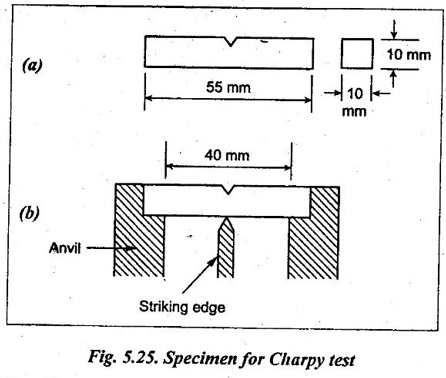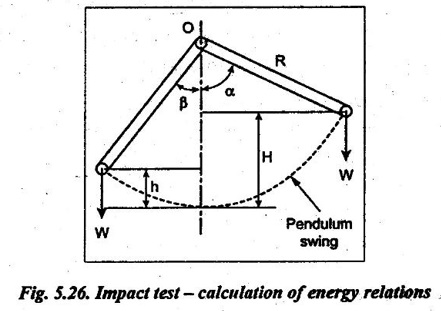The impact test is performed to study the behaviour of materials under dynamic load i.e., suddenly applied load.
IMPACT TESTS
✔ The impact test is performed to study the behaviour of materials under dynamic load i.e., suddenly applied load.
✔ Impact strength defined: The capacity of a metal to withstand blows without fracture, is known as impact strength or impact resistance.
✔ The impact test indicates the toughness of the material i.e., the amount of energy absorbed by the material during plastic deformation.
✔ The impact test also indicates the notch sensitivity of a material. The notch sensitivity refers to the tendency of some normal ductile materials to behave like a brittle materials in the presence of notches.
✔ In an impact test, a notch is cut in a standard test piece which is struck by a single blow in a impact testing machine. Then the energy absorbed in breaking the specimen can be measured from the scale provided on the impact testing machine.
1. Arrangement
The schematic arrangement of the impact testing machine is shown in Fig.5.23.

2. Types of Impact Tests
Based on the types of specimen used on impact testing machine. the impact tests can be classified into:
1. Izod test, and 2. Charpy test.
It can be noted that the impact testing machines are designed so that both types of test can be performed on the same machine with only minor adjustments.
1. Izod Test
✔ Izod test uses a cantilever specimen of size 75 mm × 10 mm × 10 mm, as shown in Fig.5.24 (a). The V-notch angle is 45° and the depth of the notch is 2 mm.

✔ The Izod specimen is placed in the vise such that it is a cantilever, as shown in Fig.5.24 (b).
2. Charpy Test
✔ The Charpy test uses a test specimen of size 55 mm × 10 mm × 10 mm, as shown in Fig.5.25 (a). The V-notch angle is 45° and the depth of the notch is 2 mm.

✔ The Charpy specimen is placed in the vise as a simply supported beam, as shown in Fig.5.25 (b).
3. Testing Procedure
The general procedure to conduct an impact test is given below :
1. The specimen is placed in the vice of the anvil.
2. The pendulum hammer is raised to known standard height depending on the type of specimen to be tested.
3. When the pendulum is released, its potential energy is converted into kinetic energy just before it strikes the specimen.
4. Now the pendulum strikes the specimen. It may be noted that the Izod specimen is hit above the V-notch and the Charpy specimen will be hit behind the V-notch.
5. The pendulum, after rupturing the specimen, rises on the other side of the machine.
6. The energy absorbed by the specimen during breaking is the weight of the pendulum times the difference in two heights of pendulum on either side of the machine.
7. Now the energy i.e., the notched impact strength, in foot- pounds or metre-kg, is measured from the scale of the impact testing machine.
4. Calculation of Energy Relations
The energy used in rupturing the specimen in both Izod and Chary tests, using the Fig.5.26, is calculated as given below:

Let W = Weight of the pendulum,
α = Angle through which the pendulum falls,
β = Angle through which the pendulum rises,
R = Distance between the centre of gravity of the pendulum and the axis of rotation,
H = Height of fall of centre of gravity of pendulum, and
h = Height of rise of centre of gravity of pendulum after striking specimen.
Initial energy = W. h
= Potential energy
= Kinetic energy of striking specimen
Remaining energy after striking specimen = K.E of carrying the pendulum to the lowest postion
= W . h
⸫ Energy delivered to the specimen = Impact value of energy in fracturing specimen
= W.H - W.h = W (H-h) …..(5.17)
In terms of angles, the energy required to break away the specimen
= WR (cos β - cos α) …..(5.18)
5. Factors Affecting Impact Strength
The factors affecting the impact strength are:
1. Angle of notch,
2. Shape of notch,
3. Impact velocity,
4. Temperature of the specimen, and
5. Dimensions of notch specimen.
No comments:
Post a Comment